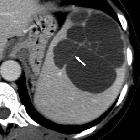lymphangioma of spleen

Splenic lymphangiomas are relatively rare benign tumors that correspond to abnormal dilatation of lymphatic channels that can be either congenital or acquired. On imaging, they usually present as lobulated and multiloculated cystic lesions without solid component or significant enhancement.
For a general discussion on this topic, please refer to the parental article on lymphangioma.
Epidemiology
Most occur in children, were rarely reported in adults .
Clinical presentation
Presentation ranges from asymptomatic incidental finding to a large multicentric, symptomatic mass requiring surgical intervention. May occur alone on spleen or as part of a systemic lymphangiomatosis .
Pathology
The cysts are thought to be formed by abnormal dilatation of lymphatic channels; this can be congenital or acquired.
Cysts tend to be subcapsular and multilocular but can be unilocular.
The cyst wall and septa are composed of thin bands of fibrous tissue lined by bland endothelium, the nature of which can be confirmed on immunohistochemistry using endothelial markers (CD31, podoplanin); this may be necessary to rule out a cystic epithelial lesion. The fibrous cyst walls/septa can show focal calcification.
Radiographic features
Ultrasound
Appear as well defined round hypoechoic lesions and may show occasional internal septation and intralocular echogenic debris . Tiny echogenic calcifications may be present.
CT
They appear as single or multiple thin-walled low attenuation masses with sharp margins that are typical subcapsular in location. They are hypodense with no enhancement. The presence of curvilinear peripheral mural calcifications suggests the diagnosis of cystic lymphangioma.
MRI
- T1: hypointense relative to the surrounding viscera. High T1 signal intensity may occur with internal bleeding or large amounts of intracystic proteinaceous content
- T2: multiloculated hyperintense areas that correspond to the dilated lymphatic spaces. The intervening septa appear as hypointense bands, corresponding to the presence of fibrous tissue
- T1 C+ (Gd): no significant enhancement
See also
Siehe auch:
- Raumforderungen der Milz
- zystische Läsionen der Milz
- Lymphangiom
- zystisches Lymphangiom
- Echinokokkose der Milz
- fokale Milzläsionen und Anomalien
und weiter:

 Assoziationen und Differentialdiagnosen zu Lymphangiom Milz:
Assoziationen und Differentialdiagnosen zu Lymphangiom Milz:




